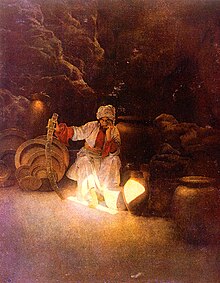
Back Duisend-en-een-nag Afrikaans Tausendundeine Nacht ALS አንድ ሺህ አንድ ሌሊቶች Amharic As mil y una nueiz AN अलिफ लैला ANP ألف ليلة وليلة Arabic ألف ليلة وليلة ARY الف ليله و ليله ARZ এহেজাৰ এনিশা (লোকগাথা) Assamese Alf layla wa-layla AST
 | |
| Language | Arabic |
|---|---|
| Genre | Frame story, folklore |
| Set in | Middle Ages |
| Text | One Thousand and One Nights at Wikisource |
| Part of a series on |
| Arabic culture |
|---|
 |
One Thousand and One Nights (Arabic: أَلْفُ لَيْلَةٍ وَلَيْلَةٌ,Alf Laylah wa-Laylah), (Persian: هزار و یک شب,Hezar-o-Yek Shab)) [1] is a collection of Middle Eastern folktales compiled in the Arabic language during the Islamic Golden Age. It is often known in English as the Arabian Nights, from the first English-language edition (c. 1706–1721), which rendered the title as The Arabian Nights' Entertainment.[2]
The work was collected over many centuries by various authors, translators, and scholars across West Asia, Central Asia, South Asia, and North Africa. Some tales trace their roots back to ancient and medieval Arabic, Persian, and Mesopotamian literature.[3] Most tales, however, were originally folk stories from the Abbasid and Mamluk eras, while others, especially the frame story, are probably drawn from the Pahlavi Persian work Hezār Afsān (Persian: هزار افسان, lit. 'A Thousand Tales'), which in turn may be translations of older Indian texts.[4]
Common to all the editions of the Nights is the framing device of the story of the ruler Shahryar being narrated the tales by his wife Scheherazade, with one tale told over each night of storytelling. The stories proceed from this original tale; some are framed within other tales, while some are self-contained. Some editions contain only a few hundred nights of storytelling, while others include 1001 or more. The bulk of the text is in prose, although verse is occasionally used for songs and riddles and to express heightened emotion. Most of the poems are single couplets or quatrains, although some are longer.
Some of the stories commonly associated with the Arabian Nights—particularly "Aladdin and the Wonderful Lamp" and "Ali Baba and the Forty Thieves"—were not part of the collection in the original Arabic versions, but were instead added to the collection by French translator Antoine Galland after he heard them from Syrian writer Hanna Diyab during the latter's visit to Paris.[5][6][7] Other stories, such as "The Seven Voyages of Sinbad the Sailor", had an independent existence before being added to the collection.
- ^ Marzolph, Ulrich (2007). "Arabian Nights". In Kate Fleet; Gudrun Krämer; Denis Matringe; John Nawas; Everett Rowson (eds.). Encyclopaedia of Islam (3rd ed.). doi:10.1163/1573-3912_ei3_COM_0021.
Arabian Nights, the work known in Arabic as Alf layla wa-layla
- ^ See illustration of title page of Grub St Edition in Yamanaka and Nishio (p. 225)
- ^ Ben Pestell; Pietra Palazzolo; Leon Burnett, eds. (2016). Translating Myth. Routledge. p. 87. ISBN 978-1-134-86256-6.
- ^ Marzolph (2007), "Arabian Nights", Encyclopaedia of Islam, vol. I, Leiden: Brill.
- ^ John Payne, Alaeddin and the Enchanted Lamp and Other Stories, (London 1901) gives details of Galland's encounter with 'Hanna' in 1709 and of the discovery in the Bibliothèque Nationale, Paris of two Arabic manuscripts containing Aladdin and two more of the added tales. Text of "Alaeddin and the enchanted lamp"
- ^ Horta, Paulo Lemos (2017-01-16). Marvellous Thieves. Harvard University Press. ISBN 978-0-674-97377-0.
- ^ Doyle, Laura (2020-11-02). Inter-imperiality: Vying Empires, Gendered Labor, and the Literary Arts of Alliance. Duke University Press. ISBN 978-1-4780-1261-0.